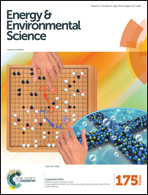Encapsulation of organic active materials in carbon nanotubes for application to high-electrochemical-performance sodium batteries†
Abstract
Sodium (Na) ion batteries are interesting candidates for replacing lithium (Li) ion batteries, primarily due to the abundance of Na in the environment. However, the performance and energy density of a Na-ion battery are inferior to those of a Li-ion battery. Organic active materials can help overcome the drawbacks associated with Na-ion batteries because of their many advantages. However, such organic polymer electrodes are subjected to a high self-discharge and low practical capacity because the polymer electrode easily dissolves in an organic electrolyte and forms an insulating layer. Therefore, in this study, we have designed a unique organic electrode in which an active polymer is encapsulated into a carbon nanotube (CNT) to form an electrode with high polymer content. The CNT is able to retain the active polymer within the electrode structure, providing an effective electronic conduction path. Moreover, the CNT can contain large amounts of active polymer and therefore exhibits superior electrochemical properties without self-discharge, making it well suited for use as a cathode material in a Na-ion battery.


 Please wait while we load your content...
Please wait while we load your content...